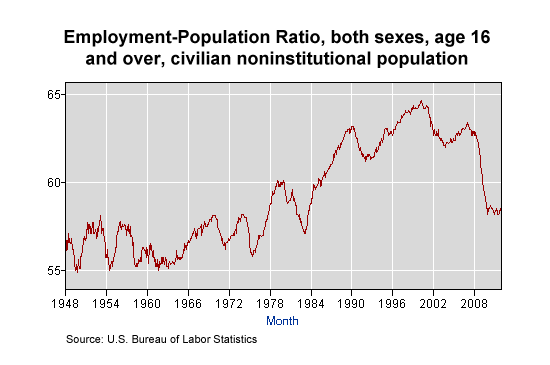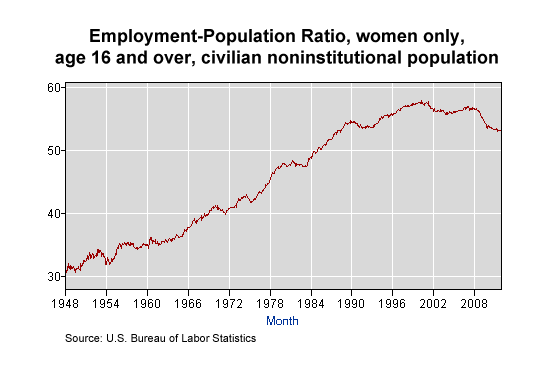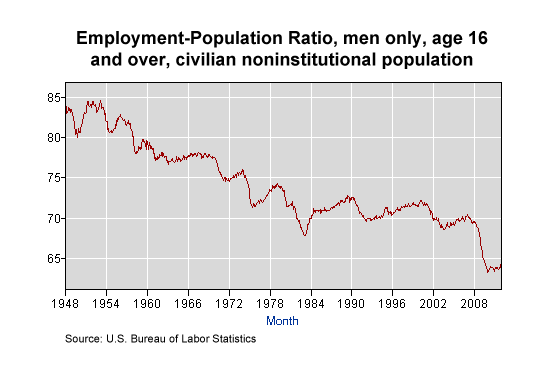Many commentators have noted in recent years that Americans have been leaving the labor force. Their departure has made interpretation of unemployment statistics more difficult, and because the Bureau of Labor Statistics (BLS) publishes six variants of the unemployment rate, considerable debate has occurred about the “real” rate of unemployment. Much of this confusion can be avoided by examining not data on unemployment, however measured, but data on employment, which are substantially less ambiguous.
When we examine the ratio of employment to population (reported by the BLS for the civilian noninstitutional population age 16 and over), we find that indeed the overall employment ratio has fallen considerably since the onset of the current recession. In 2007, the ratio for both sexes combined was about 63 percent. In 2008, it fell steadily, and by December it had reached 61 percent. In 2009, it continued to fall steadily, and by December it had reached 58.2 percent. At that point, it more or less stabilized at its recession low point, and during the past two years it has remained in the range 58-59 percent. The most recently reported ratio, for January 2012, was 58.5 percent.

As the chart shows, however, this ratio had been even lower between the late 1940s and the late 1970s. Starting in the mid-1970s, the employment-population ratio trended upward, increasing from about 57 percent to more than 64 percent by 2000. Note, too, that the ratio is pro-cyclical, rising during macroeconomic expansions and falling during macroeconomic recessions. The cyclical drop during the present recession has been larger than preceding ones, however, and it has also stuck at the bottom, whereas preceding declines were followed by quick rebounds.
The tendency of the employment-population ratio to rise during the last quarter of the twentieth century was driven entirely by an increase in the ratio for females. As the chart below shows, the employment-population ratio for women increased steadily from the late 1940s to 2000, rising from about 31 percent in 1948 more than 57 percent in 2000. It remained at a high level until the onset of the current recession, and between December 2007 and January 2012, it declined only from 56.5 percent to 52.9 percent.

The historical path of the employment-population ratio for men looks quite different. As the chart below shows, this ratio has been trending downward since the early 1950s—for roughly sixty years—although the downward trend was hardly noticeable during the quarter-century before the onset of the current recession. During this macroeconomic bust, however, the ratio for men has dropped precipitously, declining from almost 70 percent in 2006 to a low of only 63.3 percent in December 2009. Since then it has rebounded only slightly; in January 2012, it was 64.5 percent.

Thus, we see that the current recession has brought about an exceptionally steep drop in the ratio of employment to population for the entire civilian noninstitutional population age 16 and over, and that the decline has been roughly twice as great for men as for women. Both of these changes, however, should be viewed in a longer-term perspective, which shows that the employment ratio for men has moved downward for a long time, whereas the ratio for women has increased for a long time. Women have constituted a growing share of the total labor force for more than half a century, and during the present recession, that change has only surged further.
The changes described and depicted here have a variety of demographic, social, and economic causes, and labor economists and others have made great efforts to explain them. Such analysis lies outside the scope of this brief commentary. I hope, however, that the data alone contribute something toward the reader’s appreciation of recent and longer-term changes in U.S. employment.
COMMENTS
Please let us know if you're having issues with commenting.